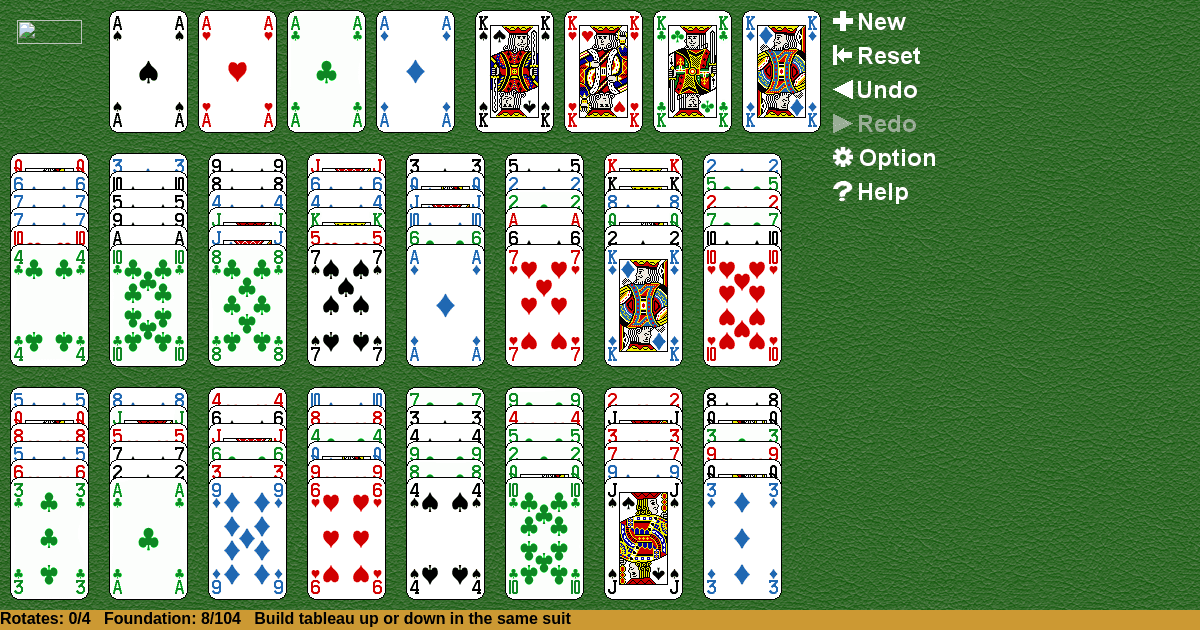Crescent Four
Home |
How to play |
FAQ |
About
How to play Crescent Four?
Game Objective:
The primary goal in Crescent Four Solitaire is to move all cards from the tableau piles onto the eight foundation piles, arranging each foundation into a complete sequence by suit: four foundations must be built up in ascending order from Ace to King, and four must be built down in descending order from King to Ace.
Setup & Layout:
Deck Composition:
Use two standard 52-card decks (total 104 cards).Foundation Setup:
Remove one Ace and one King of each suit (eight cards total) to form the eight foundation piles in the center:Four foundations start with an Ace (one per suit).
Four foundations start with a King (one per suit).
Tableau Arrangement:
Deal the remaining 96 cards face-up into 16 tableau piles, each pile containing six cards. These piles are typically arranged in a crescent or semicircular shape around the foundations.Face Orientation:
All tableau cards are dealt face-up and splayed downward, so only the top card of each pile is available for play at any time.Key Play Areas:
Foundations: Eight central piles (four Aces, four Kings).
Tableau: Sixteen outer piles of six cards each.
No stock, reserve, or cell areas are used in this variant.
Crescent Four Solitaire Rules:
Card Movement Principles:
Only the top card of any tableau pile is available to be moved.
Cards can be moved either to a foundation or onto another tableau pile, following strict sequence rules.
Foundation Building:
Ace Foundations: Build up in ascending order (Ace → 2 → … → King), by suit.
King Foundations: Build down in descending order (King → Queen → … → Ace), by suit.
Tableau Building:
Cards may be built up or down by one rank, but only onto a card of the same suit. For example, a 7♣ can be placed on a 6♣ or 8♣.
Round-the-corner building is allowed: sequences can wrap from King to Ace or Ace to King, treating those ranks as adjacent within the same suit.
Movement Restrictions:
Only one card at a time may be moved between tableau piles or onto a foundation.
Empty tableau piles cannot be filled; once a pile is empty, it remains so for the rest of the game.
Gameplay:
Player Actions:
Move the top card of any tableau pile onto a foundation if it fits the next sequence in its suit.
Move the top card of a tableau pile onto another tableau pile if it follows the up/down, same-suit rule.
Continue making moves until no further legal moves are possible.
Introducing New Cards:
No stock or reserve piles exist; all cards are in play from the start.
When No Moves Remain:
If no legal moves are possible, the game is lost or unwinnable.
In some variants, a redeal or restack mechanism is available: the bottom card of each tableau pile is moved to the top, potentially creating new moves. This is usually limited to three redeals per game.
Note: Not all implementations of Crescent Four Solitaire include redeals; check specific game rules.
Winning & Losing Conditions:
Winning Condition:
The player wins by successfully moving all 104 cards onto the eight foundation piles, completing each foundation in its suit (Ace-to-King or King-to-Ace as appropriate).
Losing/Unwinnable Condition:
The game is lost if no legal moves remain and, if applicable, all permitted redeals have been used.
Special Rules & Edge Cases:
Empty Tableau Piles:
Cannot be refilled; once a tableau pile is empty, it remains empty for the duration of the game.
Round-the-Corner Building:
Unique to Crescent Solitaire, sequences on the tableau may wrap from King to Ace or Ace to King, allowing greater flexibility in building.
Redeals (if included):
Some versions allow up to three redeals: the bottom card of each tableau pile is moved to the top, potentially unlocking new moves.
Redeals are optional and may not be present in all versions; consult specific game rules.
Multiple Copies of Each Card:
Since two decks are used, there are two copies of each card. Both must be placed correctly on the foundations for a win.
No Sequence Moves:
Only individual cards may be moved; sequences or groups of cards cannot be transferred together.
No Stock or Reserve:
All cards are dealt at the start; there is no draw pile or reserve area.
Definitions:
- Tableau: The primary play area consisting of 16 piles, each with six cards.
- Foundation: Central piles where cards are built up or down by suit to complete the game.
- Round-the-corner building: The rule allowing sequences to wrap from King to Ace or Ace to King within the same suit.
This guide provides the essential rules and procedures for playing Crescent Four Solitaire according to official and widely accepted sources.




























































